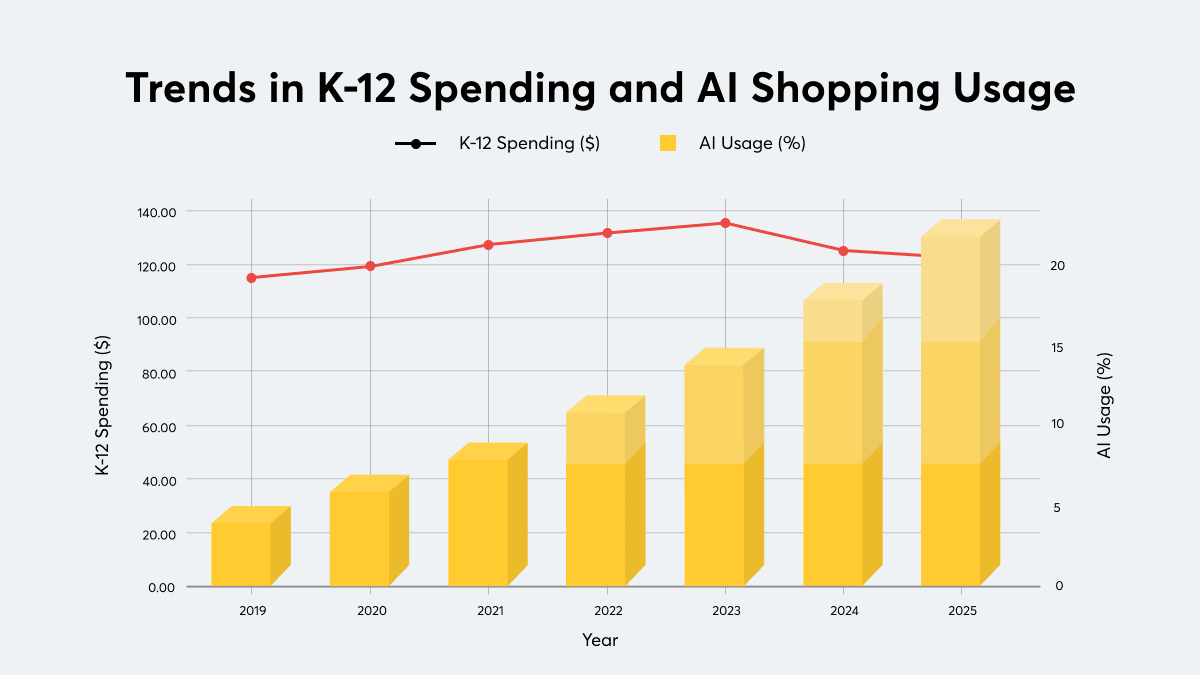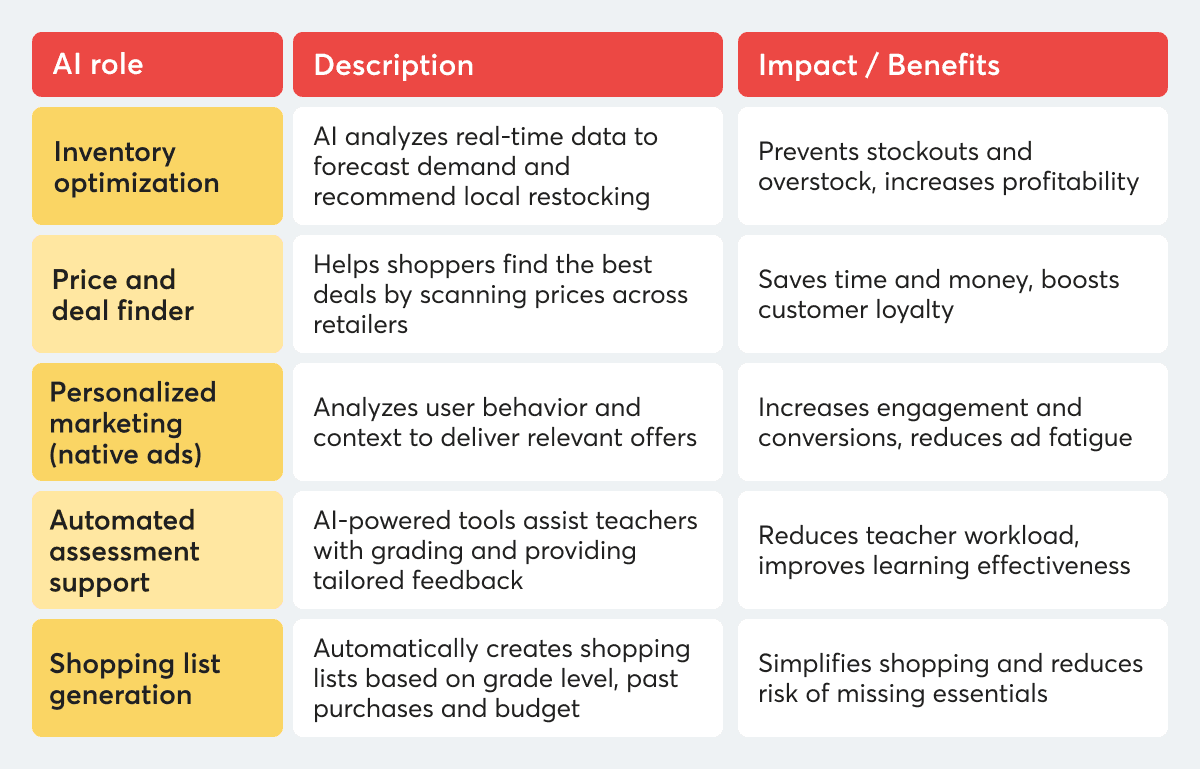Before the first school bell rings that officially marks the beginning of the new school year, most parents have done their homework on back-to-school deals, prices and product reviews. And this year, many of them are preparing for the return to school with the help of AI.
In 2024, nearly one in five back-to-school shoppers used AI to plan their purchases. Some turned to it for building lists, comparing prices, scanning reviews or tracking promotions. According to surveys:
- 76% of users relied on AI to evaluate products;
- 62% looked for savings;
- 35% simply wanted to save time.
And retailers have noticed. In turn, Best Buy, Walmart and Target are using AI to manage inventory, personalize offers and optimize promotions. Simply put, AI is quietly reshaping the entire school shopping journey, from what’s on the shelf to how consumers prepare.
That shift raises bigger questions:
- What does it mean to shop for school supplies with AI in the fold?
- What role does AI play inside the classroom?
- And most importantly for marketers: how can brands show up with smarter, more relevant messages, especially through native ads?
Let’s take a closer look at how AI is rewriting the rules of back-to-school shopping, both for students and for advertisers trying to reach them.
AI Enters the Classroom: From Buzzword to Baseline
Until recently, AI in schools felt like a tech experiment. But that phase is over. In 2025, it’s becoming part of official policy. California has already passed legislation recommending AI literacy as part of standard K–12 school curricula. Over two dozen other U.S. states have released their own guidelines for how to integrate AI into everyday learning.
These frameworks don’t push coding skills or advanced theory. Instead, they focus on:
- helping students understand how AI works;
- recognizing its limits;
- practicing ethical use.
AI literacy is now seen as a core life skill, just like reading, math or media awareness.
What AI is Actually Doing in Classrooms
This technological shift is already happening on the ground. Teachers are using AI assistants that help with:
- lesson planning;
- assessing student work;
- suggesting personalized feedback.
EdTech platforms like Code.org are building tools that automate tedious tasks, like grading quizzes, so educators can spend more time with students, not spreadsheets.
Some schools are also testing personalized learning paths powered by AI. These systems adapt based on each student’s pace and style, helping struggling learners catch up and giving accelerated students room to explore deeper topics.
The result? A classroom that’s more responsive and less one-size-fits-all.
A New Kind of Student Mindset
Students are growing up with AI tools. Whether they’re asking chatbots for help with homework or browsing recommendations tailored by algorithms, they’re learning to expect:
- fast answers;
- personalization;
- context-aware experiences.
That makes them fundamentally different from previous generations. They navigate tech fluently and trust it, rely on it and expect the same responsiveness from brands, platforms and content.
Why Marketers Should Pay Attention
For advertisers, this evolution matters. Students and their parents are already thinking and behaving in ways shaped by AI systems. They're used to:
- smart recommendations;
- curated feeds;
- content that just gets them.
So when it comes to school-related marketing, brands need to think beyond flashy discounts or generic messaging. To truly connect, they’ll need to match the intelligence and relevance their audience is growing up with, especially in formats built for context, like native ads.
The New Shopping Mindset: Cautious, Calculated and AI-Assisted
Back-to-school shopping has never been stress-free, but in recent years, it’s started earlier, felt heavier and demanded more planning than ever.
In 2025, a full 67% of shoppers started their school shopping before July, according to the National Retail Federation. That’s the highest early-start rate since 2018.
The reasons for this are:
- economic pressures;
- inflation;
- fear of price hikes due to tariffs or supply chain gaps.
Parents are actively trying to avoid future regret. Many are buying earlier, choosing discount retailers or cutting back on non-essentials and covering just the basics.
Back-to-school spending in the US has slightly decreased year-over-year, while the use of AI tools to assist with shopping is on a rapid rise.

Together, these trends point to a new kind of shopper: careful, deliberate and guided by technology.
AI Becomes a Shopping Assistant
To make things easier, families are outsourcing parts of the shopping process to AI: not in a flashy, sci-fi way but in small, practical ways that reduce stress and simplify choices.
Typical use cases include:
- Auto-generating shopping lists based on grade level or previous purchases;
- Pulling in summarized product reviews from multiple sources;
- Comparing prices across stores or bundles;
- Finding the best available deals using browser extensions or AI-powered search;
- Tracking discounts via voice assistants or chat-based prompts.
These tools come in many forms, from built-in phone assistants to retailer-specific apps. However, the behavior is surprisingly consistent: let tech narrow the field so humans don’t have to.

What might this look like in practice? A parent asks their phone assistant: “Find a back-to-school bundle for under $50 with notebooks, pens and a lunchbox.” Within seconds, AI can produce two personalized options from different retailers, highlight the best price and offer a 10% coupon found online. Say goodbye to endless browsing and overwhelming comparisons and hello to a faster way to shop smart.
In 2025, it’s no longer about what people buy, but how they expect to be helped. Increasingly, consumers expect tools and brands to do more of the thinking for them. In this environment, ads can’t feel like ads. They need to feel like answers: well-timed, well-placed and worth the click. That’s where native advertising becomes a powerful fit.
Personalized by Default: AI’s Role in Smarter Marketing
In a shopping season defined by overload, AI is helping brands deliver something rare: relevance. The days of one-size-fits-all banners are fading fast. Instead, brands are using AI to understand what shoppers are likely to need, want or worry about and tailoring their messages accordingly.
That personalization is more than saying the shopper’s name or suggesting similar products. It’s deeper. AI now enables marketers to:
- analyze real-time behavioral patterns;
- adapt messaging based on search context or device type;
- adjust creative depending on audience segment;
- and even predict which offer will lead to actual engagement.
Native Ads + AI = Less Noise, More Context
When users are constantly bombarded with offers, flashing sales and endless back-to-school checklists, native advertising becomes a quieter, but smarter, way in.
Here’s where AI fits in:
- It helps platforms match branded content with the right user, in the right moment, on the right page.
- It ensures the ad isn’t just placed, but placed with purpose, based on interest, location, time of day or content being consumed.
- It allows for A/B testing and real-time optimization, fine-tuning creative for the best results.
Native in action: A parent reading an article about prepping for the school year sees a native ad for a curated box of school supplies tailored to their region’s curriculum and budget range. It’s not a pop-up, nor is it random. It is timely and helpful.
MGID uses automated ad selection technologies that work in real time, relying on:
- contextual targeting;
- interest-based targeting;
- and environmental signals like device, location and time of day.
This combination allows for:
- dynamic creatives that adapt to different audience segments;
- personalized placements based on relevance;
- and smarter segmentation without being intrusive.
The result is clear: less pressure on the user, more meaningful engagement and content that feels aligned, not forced.
Looking Ahead: AI as a Long-Term Back-to-School Strategy
In uncertain times, price tags matter, but so do principles. Parents are looking for what feels stable, honest and human. Brands that act with consistency and clarity tend to stand out not only because they offer good deals but also because they feel reliable.
Consumers are tired of being sold to. What they want is a brand that simplifies the seemingly endless choices, respects their time and doesn’t push more than necessary. In the middle of economic tension, this kind of support matters more than ever.
The Costco Effect: Stability Wins Loyalty
One brand that nailed this approach is Costco. While many retailers are bracing for tariff-related backlash, Costco is calmly growing. Despite market volatility, they’ve stuck to a few simple rules:
- Prices stay stable, even when others raise theirs;
- Membership fees, not margins, drive most of their profit;
- Relationships with suppliers are strong, giving them agility when supply chains wobble;
- Their messaging is low-drama and focused on value and trust, not urgency or fear.
By the numbers:
- Net sales are up 9.1% YoY;
- Membership renewal rates hit 90.5% globally;
- Digital sales jumped 20.9%;
- 43M+ users visited Costco’s new warehouse tool.
Even during tariff uncertainty, executives say consumer sentiment hasn’t shifted. Members are spending more at home, remaining loyal and responding well to new digital features like personalized mailers, designed to make communication smarter and more relevant.
And while other retailers talk about adjusting to consumer anxiety, Costco simply avoids triggering it in the first place.
What Brands Can Learn (And Scale) From This
Not every brand can copy Costco’s warehouse model. However, the lesson goes beyond bulk deals. It’s about being steady, useful and easy to engage with.
And this is where AI quietly helps brands replicate that feeling, even at scale. With the right tools, marketers can:
- tailor offers based on real-time needs;
- deliver consistent value without adding friction;
- automate helpful interactions that feel human, not robotic.
Example: A retailer running a back-to-school campaign through a native ad platform like MGID might set rules to highlight only price-locked offers, low-stock warnings or bundles relevant to the user’s grade and region. On the surface, it looks like a well-placed suggestion. Behind the scenes, it’s an AI-driven strategy designed to remove stress, not add to it.
Conclusion: Time to Rethink, Retool, Reconnect
Back-to-school is a strategic moment to earn trust. Families are navigating tight budgets, long lists and digital overload. What they’re really looking for isn’t another flashy promo but confidence, simplicity and support.
That’s where brands using AI thoughtfully can shine. When:
- personalization feels human;
- elevance comes with restraint;
- and tech makes life easier,
people notice, and they remember.
Native advertising makes that kind of connection possible. It’s flexible, it fits into real-life content and it gives AI-powered strategies a natural home. Done right, it doesn’t interrupt: it adds value.
If your brand is planning a back-to-school campaign and looking to reach families where it counts, start with MGID. Sign up, explore the tools and test how native + AI can work together to make your message feel personal, timely and welcome.





